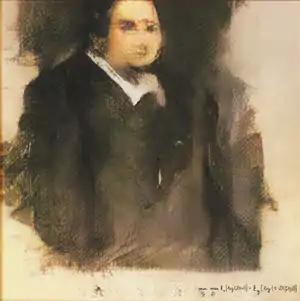Digital architecture
Digital architecture has been used to refer to other aspects of architecture that feature digital technologies. The emergent field is not clearly delineated to this point, and the terminology is also used to apply to digital skins that can be streamed images and have their appearance altered. A headquarters building design for Boston television and radio station WGBH by Polshek Partnership has been discussed as an example of digital architecture and includes a digital skin.[1]

Overview
Architecture created digitally might not involve the use of actual materials (brick, stone, glass, steel, wood).[2] It relies on "sets of numbers stored in electromagnetic format" used to create representations and simulations that correspond to material performance and to map out built artifacts.[2] Digital architecture does not just represent "ideated space"; it also creates places for human interaction that do not resemble physical architectural spaces.[2] Examples of these places in the "Internet Universe" and cyberspace include websites, multi-user dungeons, MOOs, and web chatrooms.[2]
Digital architecture allows complex calculations that delimit architects and allow a diverse range of complex forms to be created with great ease using computer algorithms.[3] The new genre of "scripted, iterative, and indexical architecture" produces a proliferation of formal outcomes, leaving the designer the role of selection and increasing the possibilities in architectural design.[3] This has "re-initiated a debate regarding curvilinearity, expressionism and role of technology in society" leading to new forms of non-standard architecture by architects such as Zaha Hadid, Kas Oosterhuis and UN Studio.[3] A conference held in London in 2009 named "Digital Architecture London" introduced the latest development in digital design practice.[4]
The Far Eastern International Digital Design Award (The Feidad Award) has been in existence since 2000 and honours "innovative design created with the aid of digital media." In 2005 a jury with members including a representative from Quantum Film, Greg Lynn from Greg Lynn FORM, Jacob van Rijs of MVRDV, Gerhard Schmitt, Birger Sevaldson (Ocean North), chose among submissions "exploring digital concepts such as computing, information, electronic media, hyper-, virtual-, and cyberspace in order to help define and discuss future space and architecture in the digital age."[5]
See also
References
- WGBH to wrap new headquarters in digital skin
- Daniela Bertol, David Foell Designing digital space page 57
- A. Ali, C. A. Brebbia Digital architecture and construction Abstract by S. Hatzellis, University of Technology, Sydney Australia page 51, 54
- "脱毛サロンの勧誘を断ったら急に態度がよそよそしくなった – 脱毛あるあるはやく言いたい~♪言うよ~♪".
- Yu-Tung Liu The Philosophy of Digital Architecture: The FEIDAD Award Architettura
Further reading
General
- Oxman, Rivka and Oxman Robert 'Architectural Design - The New Structuralism: Design, Engineering and Architectural Technologies' Wiley, 2010. ISBN 978-0-470-74227-3.
- Lynn, Greg. Animate Form. Princeton Architectural Press, 1998. ISBN 1568980833.
Education
- Roudavski, Stanislav (2011). 'Selective Jamming: Digital Architectural Design in Foundation Courses', International Journal of Architectural Computing, 9, 4, pp. 437–461
- Andia, Alfredo (2002). 'Reconstructing the Effects of Computers on Practice and Education during the Past Three Decades', Journal of Architectural Education, 56, 2, pp. 7–13
External links
Knowledge repositories
Relevant
Associations and organizations
- Association for Computer-Aided Architectural Design Research in Asia (CAADRIA)
- Association for Computer-Aided Design in Architecture (ACADIA)
- CAADFutures Foundation
- Education and research in Computer Aided Architectural Design in Europe (eCAADe)
- The Iberoamerican Society of Digital Graphics (SIGraDi)

